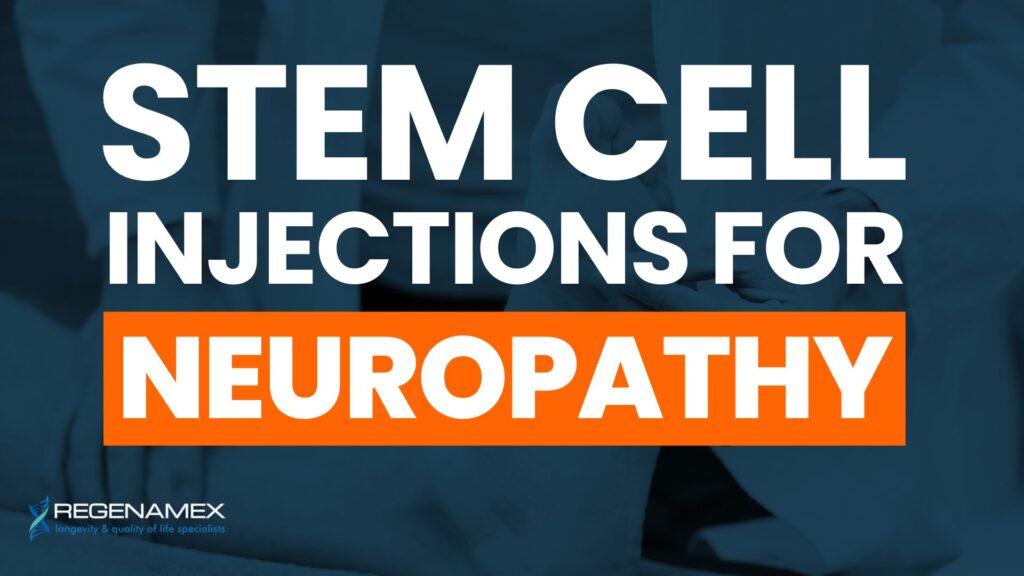
The Science Behind Stem Cell Injections for Neuropathy
Stem cell injections for neuropathy work by harnessing the unique properties of mesenchymal stem cells to address nerve damage and inflammation. Neuropathy typically stems from impaired blood flow, chronic inflammation, or autoimmune attack on the peripheral nerves. MSCs, especially those derived from Wharton’s jelly, are known for their potent anti-inflammatory effects, immune regulation, and ability to support tissue regeneration. When injected into the site of nerve damage or delivered systemically, these stem cells home in on injured tissue and begin releasing bioactive factors that promote healing.
These therapeutic effects occur through three core mechanisms:
Immunomodulation: MSCs calm overactive immune responses that contribute to nerve damage.
Angiogenesis: They stimulate the formation of new blood vessels, improving nutrient and oxygen supply to nerves.
Neuroregeneration: MSCs release growth factors like BDNF and NGF that support nerve regeneration and myelin repair.
Research has shown that stem cell therapy can improve sensation, reduce pain intensity, and enhance quality of life in patients with diabetic neuropathy and other peripheral nerve disorders. At Regenamex, each treatment is customized to target the underlying pathology, ensuring that patients receive a therapy tailored to their specific condition.
Conditions That Respond to Stem Cell Injections for Neuropathy

Many different patient populations can benefit from stem cell injections for neuropathy, particularly those with peripheral nerve damage caused by underlying chronic conditions. Whether neuropathy is a result of metabolic disease, chemotherapy, or autoimmunity, the regenerative potential of MSCs can offer measurable improvements in nerve health.
Common conditions treated include:
Diabetic peripheral neuropathy
Chemotherapy-induced neuropathy
Sciatic nerve pain and radiculopathy
Post-surgical or traumatic nerve damage
Idiopathic neuropathy
Neuropathy due to autoimmune diseases such as lupus or MS
In addition to chronic cases, individuals with acute nerve injuries or those recovering from orthopedic procedures can also benefit from stem cell therapy. The treatment is particularly appealing to those who have not responded well to conventional approaches like gabapentin, opioids, or nerve blocks. By using regenerative medicine rather than symptom suppression, stem cell therapy opens the door to actual nerve repair, functional restoration, and lasting relief.
What Kind of Results Can Patients Expect?
Patients who undergo stem cell injections for neuropathy at Regenamex typically begin noticing changes within the first 4 to 6 weeks following treatment. Improvements continue over time, with maximum benefits often observed around the 3 to 6-month mark. Since the regenerative process initiated by MSCs is gradual, patients experience ongoing progress rather than a quick but temporary fix.
Expected outcomes include:
Reduced pain and tingling sensations
Improved balance and proprioception
Decreased numbness and hypersensitivity
Greater mobility and muscle strength
Reduced need for pain medications
At Regenamex, patients receive personalized monitoring to track improvements over time. Follow-ups may include nerve conduction studies, mobility assessments, and clinical evaluations to document success. Families and patients often report a return to daily activities, better sleep quality, and less reliance on assistive devices. The treatment isn’t just about alleviating pain—it’s about restoring lives.
Why Regenamex Uses Wharton’s Jelly MSCs Exclusively

Not all stem cells are created equal. At Regenamex, we exclusively use mesenchymal stem cells derived from Wharton’s jelly and placental tissue due to their superior regenerative capabilities, safety profile, and ethical sourcing. Wharton’s jelly MSCs are collected non-invasively from the umbilical cord after healthy, full-term births, making them both ethically and biologically ideal for therapeutic use.
Compared to adipose- or bone marrow-derived MSCs, Wharton’s jelly cells:
Are more biologically active and younger
Have higher concentrations of anti-inflammatory proteins and growth factors
Do not require surgery or anesthesia to collect
Have a lower risk of immune rejection or cellular aging
Because neuropathy often involves inflammation and nerve degeneration, the rich composition of neuroprotective agents in Wharton’s jelly MSCs makes them the optimal choice. At Regenamex, our protocols avoid the limitations and risks associated with autologous fat or bone marrow extraction, ensuring that every patient receives the most effective and safest form of regenerative therapy available.
How Stem Cell Injections Are Administered for Neuropathy
The treatment protocol for stem cell injections for neuropathy at Regenamex begins with a thorough consultation and diagnostic review. Once a patient is deemed eligible, they are assigned a customized plan that determines cell dosage, injection route, and follow-up care.
Key treatment parameters:
Cell dosage: 1 to 5 million MSCs per kilogram of body weight
Delivery methods: IV infusion, local perineural injection, or intrathecal (in some cases)
Treatment duration: 1 to 3 clinical sessions across 2 to 4 days
All procedures are performed in a licensed, sterile environment by experienced medical professionals. Patients are monitored for 24 to 48 hours and provided with post-treatment care instructions. These may include physical therapy, anti-inflammatory nutrition plans, and follow-up evaluations to support the healing process. Our comprehensive approach ensures not only safety but also optimal results.
Why Regenamex Is the Top Choice for Neuropathy Treatment with Stem Cells

Regenamex is a fully licensed regenerative medicine clinic in Mexico, offering world-class care to patients from around the globe. We specialize in ethical, science-driven therapies using only Wharton’s jelly and placental MSCs—never adipose or bone marrow. This ensures consistency, safety, and unmatched regenerative potential in every treatment.
Why patients trust Regenamex:
Affordable, transparent pricing ($2,500 to $12,000 USD)
Personalized stem cell protocols
Travel and lodging support for international patients
Multilingual staff and concierge care
Ethical sourcing and medical-grade manufacturing
To learn more, visit our Stem Cell Therapy Services or Contact Regenamex. For scientific reference, explore this PubMed study on MSCs and neuropathy and the Mayo Clinic’s overview of neuropathy.
Frequently Asked Questions About Cervical Disc Replacement or Stem Cell Therapy
Stem cell injections for neuropathy involve the use of mesenchymal stem cells (MSCs), which are known for their regenerative, anti-inflammatory, and neuroprotective properties. These stem cells are introduced either locally or systemically into the body, where they migrate to damaged nerve tissues. Once there, they help reduce inflammation, regulate immune responses, and release a wide range of growth factors that support the repair of nerve fibers, improve myelin sheath integrity, and stimulate new blood vessel formation. This multi-pronged regenerative process helps restore function and sensation in areas affected by neuropathy, offering a potential alternative to chronic medication or invasive procedures.
Stem cell therapy for neuropathy has a favorable safety profile, particularly when conducted in a licensed clinical environment such as Regenamex. All stem cells used are ethically sourced and rigorously tested for quality, viability, and sterility. Since these MSCs are derived from Wharton’s jelly and administered without the need for anesthesia or surgery, the risk of complications is minimal. Patients are monitored closely during and after the procedure, and side effects—if any—are typically mild and temporary, such as fatigue or low-grade fever.
Many patients start experiencing subtle changes within the first month after stem cell injections, including reduced pain and improved nerve sensitivity. More substantial progress generally becomes noticeable around the 3-month mark, with continued improvement reported up to a year post-treatment. The body’s regenerative processes take time, and outcomes may depend on factors such as the extent of nerve damage, the patient's age, underlying health conditions, and adherence to post-treatment recommendations.
Wharton's jelly-derived MSCs are younger and more biologically potent than those obtained from fat or bone marrow. Unlike adipose or bone marrow extraction, which involves invasive procedures and yields older, less active cells, Wharton’s jelly MSCs are collected ethically from umbilical cords after healthy births. These cells demonstrate superior proliferation capacity, higher expression of neurotrophic and anti-inflammatory factors, and minimal risk of immune rejection. Their rich cellular profile makes them especially effective for addressing nerve-related conditions like neuropathy.
The total cost of stem cell therapy for neuropathy at Regenamex typically ranges between $2,500 and $12,000 USD. This price reflects factors such as the number of stem cells administered, the delivery method (IV or local injection), and the overall complexity of the case. Regenamex prides itself on transparent pricing with no hidden fees, and every treatment plan includes pre-treatment assessments, medical supervision, follow-up care, and patient support services.
Diabetic neuropathy is one of the leading indications for stem cell therapy, and Regenamex has helped numerous diabetic patients reduce their nerve pain and regain sensation. The anti-inflammatory and vascular benefits of Wharton’s jelly MSCs can address the root causes of diabetic neuropathy, such as poor blood flow and nerve degeneration. Many patients experience relief from burning, tingling, and numbness while also gaining improvements in mobility and quality of life. This therapy may even reduce dependence on conventional medications like gabapentin.

